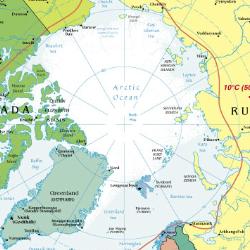On Aug. 2, after being escorted by a nuclear-powered icebreaker and another research vessel, two Russian mini-submarines traveled more than two miles below the ice at the North Pole and planted a titanium Russian flag in the seafloor, claiming the underwater territory for Moscow. The publicity stunt played to huge audiences in the Russian media and on state-run television, where the tone of the coverage resembled that given to Soviet cosmonauts. Elsewhere, the underwater mission was greeted with a mixture of humor and anxiety. Late night talk shows worried what the land grab would mean for Santa's village and his elves, and even Canada's foreign affairs minister, Peter MacKay, mocked the Russian mission. "This isn't the 15th century. You can't go . . . just plant flags and say, 'We're claiming this territory,'" MacKay told CTV. Whatever the scientific merits of the Russian exploration, the publicity stunt of planting a flag on the ocean floor of the North Pole brought attention to what could prove to be the most important territorial dispute of the 21st century.
Russian Claims to Pole Foreshadow More Arctic Disputes to Come

